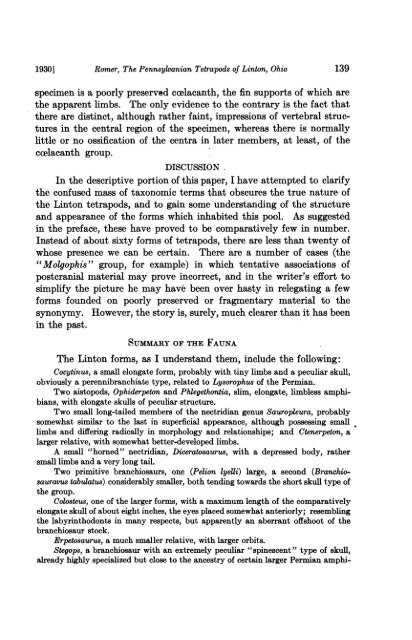View/Open - American Museum of Natural History
View/Open - American Museum of Natural History
View/Open - American Museum of Natural History
Create successful ePaper yourself
Turn your PDF publications into a flip-book with our unique Google optimized e-Paper software.
19301<br />
Romer, The Pennsylvanian Tetrapods <strong>of</strong> Linton, Ohio<br />
139<br />
specimen is a poorly preserved ccelacanth, the fin supports <strong>of</strong> which are<br />
the apparent limbs. The only evidence to the contrary is the fact that<br />
there are distinct, although rather faint, impressions <strong>of</strong> vertebral structures<br />
in the central region <strong>of</strong> the specimen, whereas there is normally<br />
little or no ossification <strong>of</strong> the centra in later members, at least, <strong>of</strong> the<br />
ccelacanth group.<br />
DISCUSSION<br />
In the descriptive portion <strong>of</strong> this paper, I have attempted to clarify<br />
the confused mass <strong>of</strong> taxonomic terms that obscures the true nature <strong>of</strong><br />
the Linton tetrapods, and to gain some understanding <strong>of</strong> the structure<br />
and appearance <strong>of</strong> the forms which inhabited this pool. As suggested<br />
in the preface, these have proved to be comparatively few in number.<br />
Instead <strong>of</strong> about sixty forms <strong>of</strong> tetrapods, there are less than twenty <strong>of</strong><br />
whose presence we can be certain. There are a number <strong>of</strong> cases (the<br />
"Molgophis" group, for example) in which tentative associations <strong>of</strong><br />
postcranial material may prove incorrect, and in the writer's effort to<br />
simplify the picture he may have been over hasty in relegating a few<br />
forms founded on poorly preserved or fragmentary material to the<br />
synonymy. However, the story is, surely, much clearer than it has been<br />
in the past.<br />
SUMMARY OF THE FAUNA<br />
The Linton forms, as I understand them, include the following:<br />
Cocytinus, a small elongate form, probably with tiny limbs and a peculiar skull,<br />
obviously a perennibranchiate type, related to Lysorophus <strong>of</strong> the Permian.<br />
Two aistopods, Ophiderpeton and Phlegethontia, slim, elongate, limbless amphibians,<br />
with elongate skulls <strong>of</strong> peculiar structure.<br />
Two small long-tailed members <strong>of</strong> the nectridian genus Sauropleura, probably<br />
somewhat similar to the last in superficial appearance, although possessing small<br />
limbs and differing radically in morphology and relationships; and Ctenerpeton, a<br />
larger relative, with somewhat better-developed limbs.<br />
A small "horned" nectridian, Diceratosaurus, with a depressed body, rather<br />
small limbs and a very long tail.<br />
Two primitive branchiosaurs, one (Pelion lyeUi) large, a second (Branchiosauravus<br />
tabulatus) considerably smaller, both tending towards the short skull type <strong>of</strong><br />
the group.<br />
Colosteus, one <strong>of</strong> the larger forms, with a maximum length <strong>of</strong> the comparatively<br />
elongate skull <strong>of</strong> about eight inches, the eyes placed somewhat anteriorly; resembling<br />
the labyrinthodonts in many respects, but apparently an aberrant <strong>of</strong>fshoot <strong>of</strong> the<br />
branchiosaur stock.<br />
Erpetosaurus, a much smaller relative, with larger orbits.<br />
Stegops, a branchiosaur with an extremely peculiar "spinescent" type <strong>of</strong> skull,<br />
already highly specialized but close to the ancestry <strong>of</strong> certain larger Permian amphi-
















